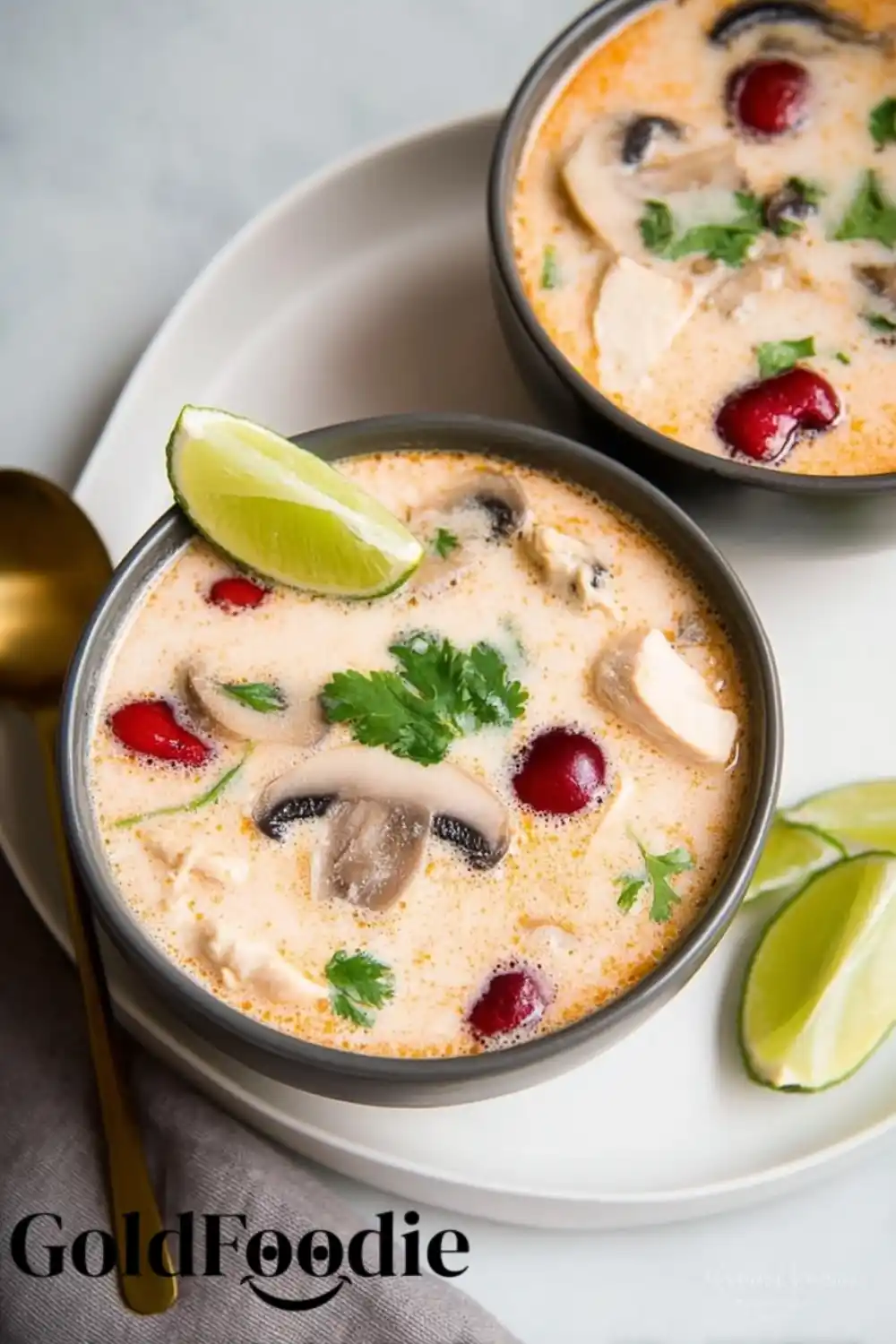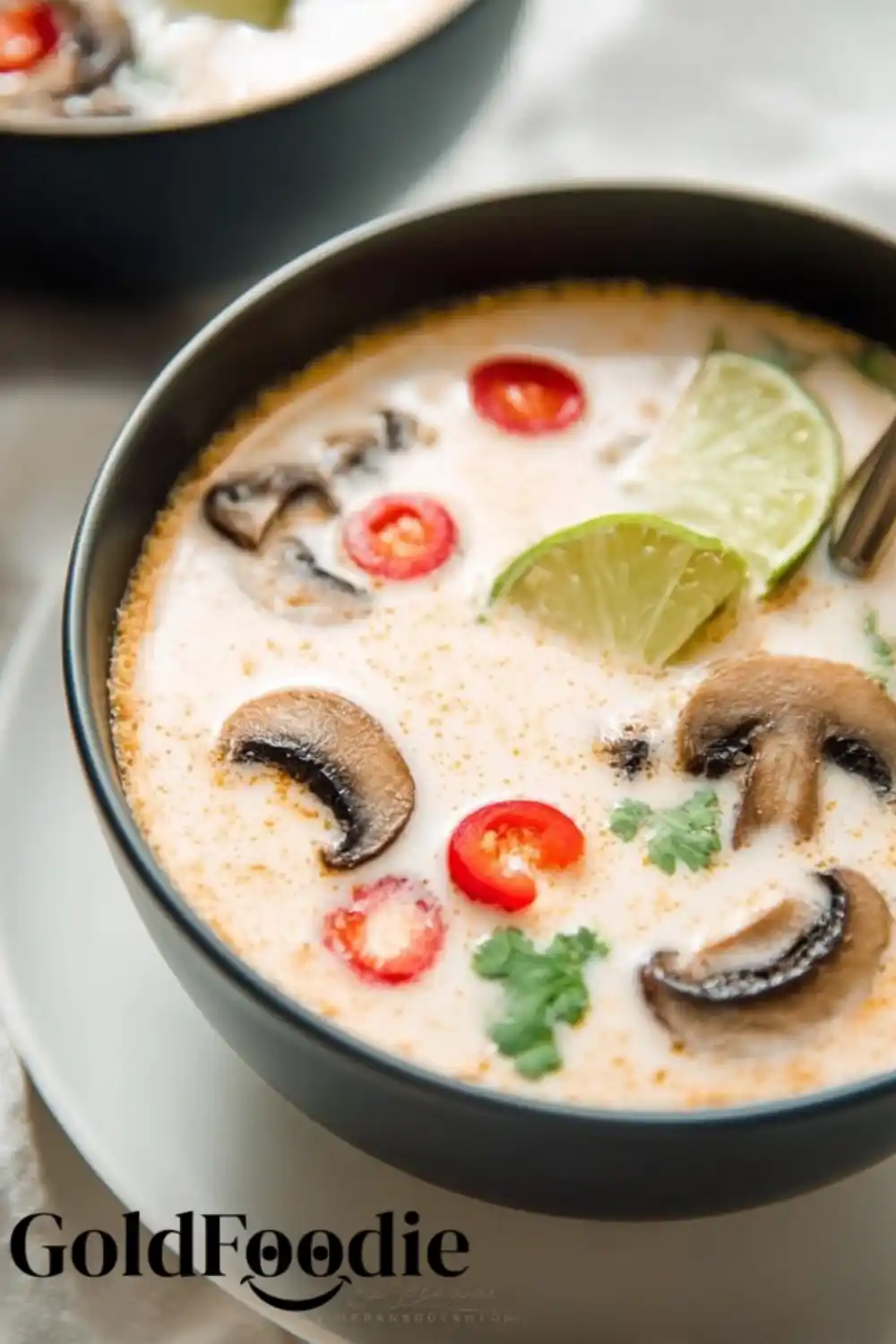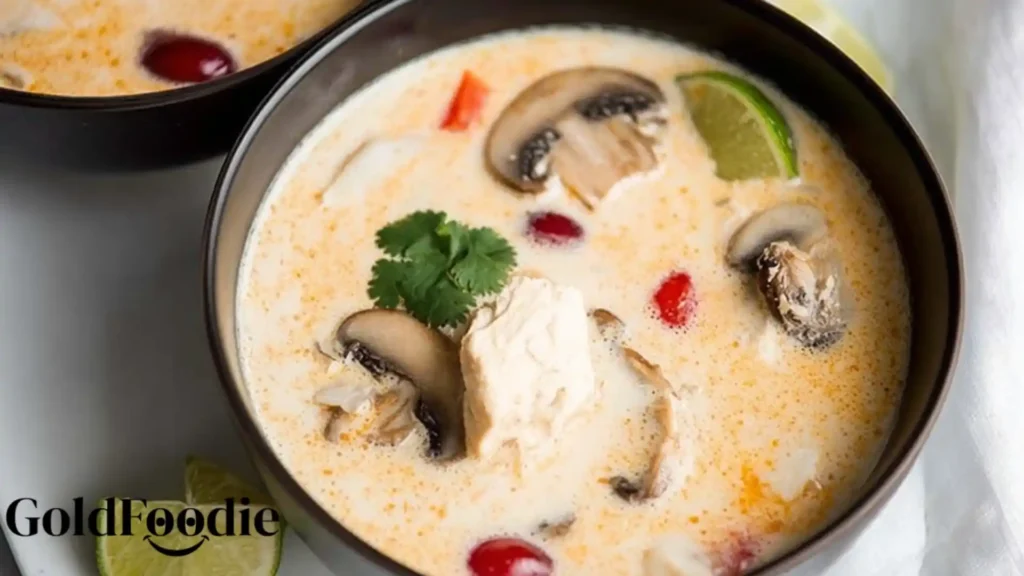Craving rich, creamy, and tangy flavors? This easy Tom Kha Gai recipe brings authentic Thai soup right to your kitchen. It’s a comforting Thai coconut soup that delivers complex tastes without complicated steps, perfect for busy parents or beginners. You can enjoy the incredible balance of sweet, sour, and savory with fresh ingredients. Get ready to create a satisfying meal that tastes just like your favorite takeout, but even better! This simple guide makes delicious homemade Tom Kha Gai achievable for everyone tonight.
Table of Contents
Why You’ll Love This Thai Soup Recipe
This homemade Thai soup offers a true flavor explosion in every spoonful. You’ll savor the perfect blend of creamy coconut, sweet, salty, spicy, and bright citrus notes that tantalize your taste buds. All ingredients are simple, fresh, and readily available at most grocery stores, making this a convenient and approachable recipe for any home cook. We also include fantastic modifications for Whole30, paleo, and vegan diets, ensuring everyone can enjoy this incredibly delicious dish. Forget calling for takeout; this easy Tom Kha Gai delivers incredible satisfaction right from your own kitchen.

Ingredients for Authentic Thai Tom Kha Gai Soup
Making authentic Thai soup starts with carefully selected, fresh ingredients. This comprehensive list provides everything you need for a truly flavorful Tom Kha Gai experience.
Wet Ingredients:
- 1 tablespoon coconut oil
- 4 cups chicken broth (see Notes if vegan or on Whole30)
- 4 cups unsweetened, full-fat coconut cream from a can; or full-fat unsweetened coconut milk (see Notes)
- 2-3 tablespoons fresh lime juice
Aromatics:
- Half of one onion, thinly sliced
- 2 cloves garlic, chopped
- Half of one red jalapeño pepper, sliced; or 1-3 Thai chiles, halved
- 3 ¼-inch slices galangal or ginger
- 1 lemongrass stalk, pounded with the side of a knife and cut into 2-inch long pieces
- 2 teaspoons red Thai curry paste
Proteins & Vegetables:
- 2 medium chicken breasts, cut into bite-sized pieces (approximately 1 pound)
- 8 ounces white mushroom caps, sliced
Seasonings & Garnish:
- 1-2 tablespoons coconut sugar (see Notes for Whole30 option)
- 1 ½ – 2 tablespoons fish sauce, plus more to taste (see Notes if on Whole30 or vegan)
- 2-3 green onions, sliced thin
- Fresh cilantro, chopped, for garnish
Notes & Substitutions
Coconut cream is thicker and richer than coconut milk, giving your Tom Kha Gai a more luxurious, velvety texture and body. You can easily substitute chicken with shrimp, firm tofu cubes, or extra vegetables to change the protein and cater to different preferences. For a Whole30-compliant Thai soup, ensure your chicken broth is explicitly Whole30-approved, use coconut aminos instead of coconut sugar for sweetness, and source a Whole30-approved fish sauce.
While fresh ginger is a suitable alternative to galangal, understanding the distinct culinary differences between galangal and ginger can enhance the authentic flavor of your Thai soup.
Similarly, fresh lime juice can brilliantly replace makrut lime leaves for that essential bright, citrusy aroma and tang.
Equipment You’ll Need
Gathering your tools beforehand makes the cooking process smooth and enjoyable. You will need a medium-sized pot or Dutch oven, ideal for simmering your aromatic broth to perfection.
A sturdy cutting board and a sharp knife are essential for efficiently prepping all your fresh aromatics and protein. Keep a fine-mesh strainer or a slotted spoon handy for easily removing infused ingredients.
Finally, measuring cups and spoons are crucial for ensuring precise seasoning, achieving the perfect authentic Tom Kha Gai flavor profile.
How to Make Thai Tom Kha Gai Soup (Step-by-Step Instructions)
Crafting this truly delicious Thai soup is much simpler than you might imagine, even for beginner cooks. Follow these clear, step-by-step instructions to effortlessly bring incredible Tom Kha Gai to your family’s table tonight.
- Step 1: Sauté Aromatics. In a medium pot or Dutch oven, begin by heating the coconut oil over medium heat. Add the thinly sliced onion, chopped garlic, sliced jalapeño or chiles, galangal or ginger, pounded lemongrass, and the aromatic red curry paste. Cook, stirring frequently with a wooden spoon, for about 5 minutes, or until the onions have softened and the entire mixture becomes wonderfully fragrant. This crucial step meticulously builds the complex, aromatic foundation of your delightful Tom Kha Gai flavor.
- Step 2: Infuse the Broth. Carefully pour in the chicken broth and bring the mixture to a rolling boil. Immediately reduce the heat to a gentle simmer. Allow it to simmer uncovered for a full 30 minutes. This extended simmering time allows all the beautiful, potent aromatic flavors from the spices and herbs to fully infuse into the broth, creating a deeply fragrant and incredibly flavorful base for your homemade Thai soup.
- Step 3: Strain and Add Cream & Protein. Once the broth has fully infused, carefully strain out all the cooked aromatics (the garlic, onions, lemongrass, and ginger) from the broth using a fine-mesh sieve and discard them. They have imparted their magic! Return the now richly flavored, clear broth to the clean pot. Stir in the unsweetened full-fat coconut cream (or coconut milk), your bite-sized chicken breast pieces (or tofu or shrimp), and the sliced white mushrooms.
- Step 4: Cook & Season. Continue to simmer the soup gently until the chicken breast pieces are just cooked through and tender. It is important not to overcook the chicken to maintain its juicy texture. Once cooked, stir in the fish sauce, coconut sugar (or coconut aminos for Whole30 compliance), and fresh lime juice. Now, taste the soup and add more of each seasoning to your preference until the sweet, sour, salty, and spicy flavors are perfectly balanced and sing on your palate.
- Step 5: Garnish and Serve. Cook for just 2 more minutes to allow all the wonderful flavors to meld together seamlessly. Ladle the hot, aromatic Tom Kha Gai into individual serving bowls. Top generously with freshly sliced green onions and a generous sprinkle of fresh chopped cilantro for a vibrant burst of freshness, color, and additional aroma. Serve immediately and savor every spoonful of your authentic homemade Thai soup!

Pro Tips for the Best Thai Soup
Mastering your homemade Tom Kha Gai is truly all about paying attention to a few key details that elevate the flavors. First, always bruise your lemongrass vigorously by pounding it with the back of a knife or a rolling pin. This essential step effectively ruptures its fibers, releasing its crucial essential oils for maximum flavor infusion into your Thai soup.
Next, make it a priority to expertly balance the key tastes: sweet, sour, salty, and spicy. Adjust your coconut sugar, fresh lime juice, fish sauce, and chiles accordingly until it hits perfection. Don’t be afraid to adjust the spice level by adding more fresh Thai chiles or increasing the red curry paste to suit your personal preference. Remember not to overcook your chicken or shrimp; they should remain wonderfully tender and juicy. Always taste and adjust seasonings right at the end to achieve that perfect, authentic balance.
Serving, Storage & Variations
Serve your comforting, steaming hot Thai soup immediately. It’s wonderfully satisfying either on its own for a lighter yet filling meal or, traditionally, alongside a bowl of fragrant jasmine rice to soak up every last drop of that creamy, flavorful broth. For storage, any leftover Tom Kha Gai can be kept in an airtight container in the refrigerator for up to 3-4 days. When reheating, do so gently on the stovetop over low heat, stirring occasionally, to prevent the coconut milk from separating.
While freezing is possible, sometimes the coconut milk texture can slightly change upon thawing. For exciting variations, feel free to swap the chicken for other proteins like thinly sliced beef, tender pork, or even a mix of seafood. Boost the vegetable content significantly by adding bell peppers, crunchy bamboo shoots, or tender baby corn during the simmering stage, or stir in spinach at the very end.
Nutrition Information
This hearty Thai soup offers a rich and fulfilling meal, packed with flavor and beneficial ingredients. Here are the approximate nutritional values per serving, based on the ingredients listed in this recipe. Please note that these values are estimates only and can vary based on specific brands used, portion sizes, and slight ingredient preparation differences. This information is provided for general guidance and is not intended as a substitute for professional nutritional or medical advice.
| Nutrition | Value |
|---|---|
| Serving Size | 1 serving |
| Calories | 524 kcal |
| Protein Content | 24 g |
| Fat Content | 43 g |
| Saturated Fat Content | 36 g |
| Trans Fat Content | 0.01 g |
| Cholesterol Content | 48 mg |
| Sodium Content | 813 mg |
| Carbohydrate Content | 17 g |
| Fiber Content | 5 g |
| Sugar Content | 9 g |
| Potassium Content | 1026 mg |
| Net Carbs | 12 g |
| Vitamin A | 351 IU |
| Vitamin C | 14 mg |
| Calcium | 55 mg |
| Iron | 4 mg |
Frequently Asked Questions About Thai Soup
What is Tom Kha Gai?
Tom Kha Gai is a classic, creamy Thai coconut soup, celebrated globally for its unique balance of creamy, distinctively sour, and mildly spicy flavors. “Tom Kha” refers to a galangal-based soup, and “Gai” literally means chicken, highlighting its primary protein and aromatic roots.
Where can I find fresh lemongrass?
You can usually find fresh lemongrass stalks in the well-stocked produce section of larger mainstream grocery stores or, more reliably and with greater variety, at most Asian specialty markets. Look for stalks that are firm, fragrant, and vibrant green.
Can I make this soup vegan?
Absolutely, making this delicious Thai soup vegan is quite straightforward! Simply use a high-quality vegetable broth, omit the chicken (substitute with firm tofu cubes, tempeh, or extra mushrooms), and use soy sauce or tamari instead of traditional fish sauce for seasoning.
What’s the difference between Tom Yum and Tom Kha?
While both are incredibly popular and flavorful Thai soups, Tom Yum is typically characterized by being spicier, clearer, and possessing a more pronounced sour and hot kick. Tom Kha Gai, conversely, is distinctly known for its rich, creamy coconut milk base and a milder, yet deeply aromatic and flavorful profile.
Can I make this soup spicier?
Yes, you can very easily increase the spice level to suit your personal preference. To add more heat, simply incorporate more fresh Thai chiles into the sautéing aromatics stage, or increase the amount of red Thai curry paste used in the recipe.
Conclusion
You’ve just discovered how wonderfully simple and incredibly satisfying it is to create an authentic homemade Thai soup. This easy Tom Kha Gai recipe truly proves that restaurant-quality, complex flavors are entirely achievable in your own kitchen, even for busy parents and beginner cooks.
Enjoy the rich, creamy texture and the vibrant, harmonious dance of sweet, sour, and spicy notes that perfectly define this beloved classic dish. Don’t hesitate to whip up this comforting and deeply satisfying meal tonight! We can’t wait for you to try it. Please share your comments, reviews, and photos – we absolutely love hearing from you!

Delicious Homemade Thai Soup: Easy Tom Kha Gai Recipe
Ingredients
Equipment
Method
- Heat coconut oil in a medium pot, then sauté onion, garlic, pepper, galangal/ginger, lemongrass, and red curry paste for 5 minutes until softened. Add chicken broth, bring to a boil, then reduce heat and simmer for 30 minutes.
- Strain out and discard the aromatics. Stir in coconut cream or milk, chicken, and mushrooms. Simmer until the chicken is cooked through.
- Add fish sauce, coconut sugar (or aminos), and lime juice; adjust to taste. Cook for 2 more minutes, then ladle into bowls and garnish with green onions and cilantro.
Notes
Hi there, I’m chef living in New York City. Every morning, I wake up to the sounds of my little one’s laughter and the comforting routine of preparing breakfast for my family my husband, our child, and my beloved mother, who’s become both my rock and my inspiration since my father passed away. As the only daughter left in our family, I feel a deep responsibility to carry on his memory whenever I step into the kitchen.








